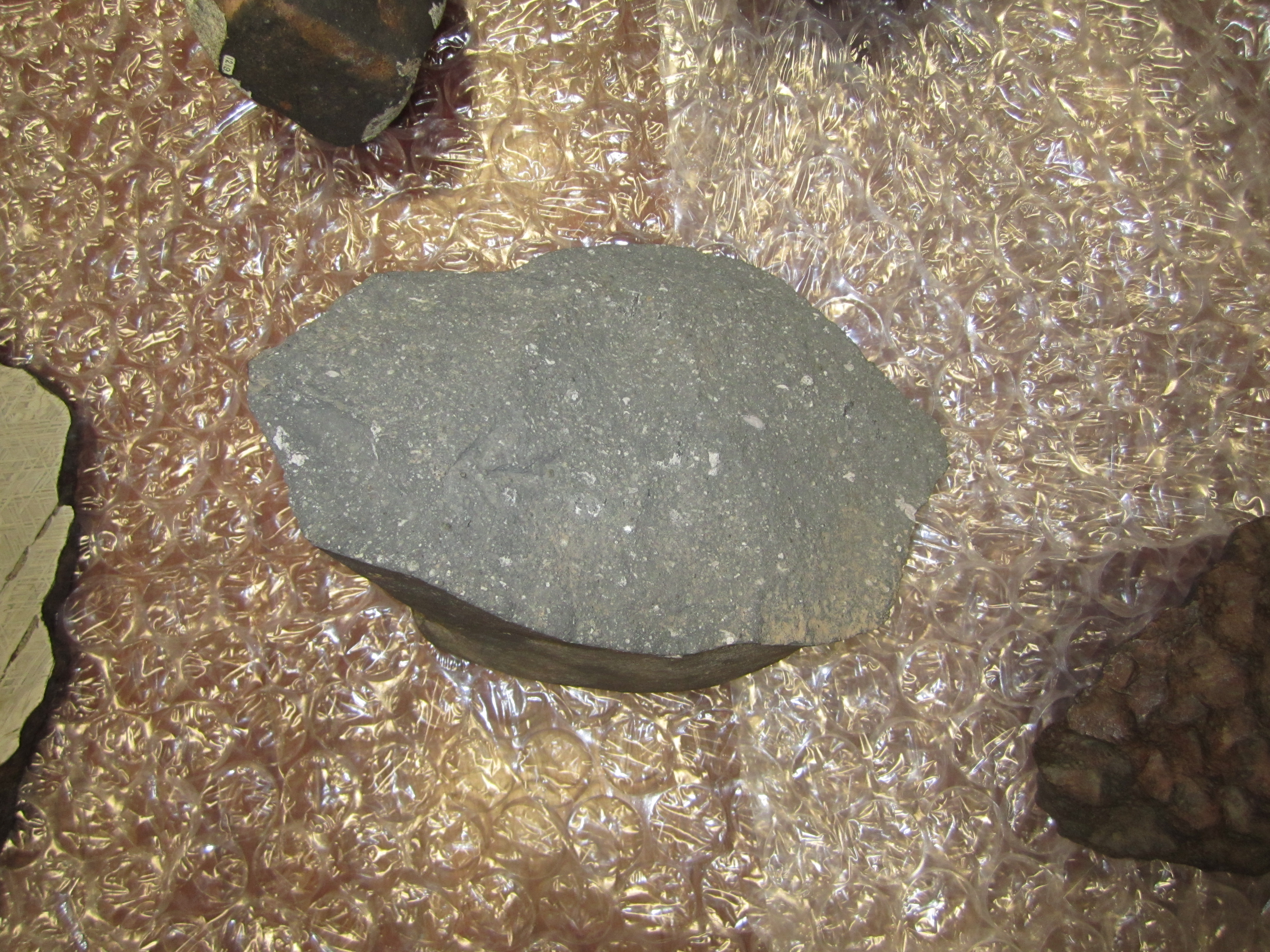Calcium–aluminium-rich Inclusion on:
[Wikipedia]
[Google]
[Amazon]
 A calcium–aluminium-rich inclusion or Ca–Al-rich inclusion (CAI) is a submillimeter- to centimeter-sized light-colored
A calcium–aluminium-rich inclusion or Ca–Al-rich inclusion (CAI) is a submillimeter- to centimeter-sized light-colored
calcium
Calcium is a chemical element; it has symbol Ca and atomic number 20. As an alkaline earth metal, calcium is a reactive metal that forms a dark oxide-nitride layer when exposed to air. Its physical and chemical properties are most similar to it ...
- and aluminium
Aluminium (or aluminum in North American English) is a chemical element; it has chemical symbol, symbol Al and atomic number 13. It has a density lower than that of other common metals, about one-third that of steel. Aluminium has ...
-rich inclusion
Inclusion or Include may refer to:
Sociology
* Social inclusion, action taken to support people of different backgrounds sharing life together.
** Inclusion (disability rights), promotion of people with disabilities sharing various aspects of lif ...
found in carbonaceous chondrite
Carbonaceous chondrites or C chondrites are a class of chondritic meteorites comprising at least 8 known groups and many ungrouped meteorites. They include some of the most primitive known meteorites. The C chondrites represent only a small propo ...
meteorite
A meteorite is a rock (geology), rock that originated in outer space and has fallen to the surface of a planet or Natural satellite, moon. When the original object enters the atmosphere, various factors such as friction, pressure, and chemical ...
s. The four CAIs that have been dated using the Pb-Pb chronometer yield a weighted mean age of 4567.30 ± 0.16 Myr. As CAIs are the oldest dated solids, this age is commonly used to define the age of the Solar System.
Description
CAIs consist ofmineral
In geology and mineralogy, a mineral or mineral species is, broadly speaking, a solid substance with a fairly well-defined chemical composition and a specific crystal structure that occurs naturally in pure form.John P. Rafferty, ed. (2011): Mi ...
s that are among the first solid
Solid is a state of matter where molecules are closely packed and can not slide past each other. Solids resist compression, expansion, or external forces that would alter its shape, with the degree to which they are resisted dependent upon the ...
s condensed from the cooling protoplanetary disk
A protoplanetary disk is a rotating circumstellar disc of dense gas and dust surrounding a young newly formed star, a T Tauri star, or Herbig Ae/Be star. The protoplanetary disk may not be considered an accretion disk; while the two are sim ...
. They are thought to have formed as fine-grained condensates from a high temperature (>1300 K) gas that existed in the protoplanetary disk at early stages of Solar System formations. Some of them were probably remelted later resulting in distinct coarser textures. The most common and characteristic minerals in CAIs include anorthite
Anorthite (< ''an'' 'not' + ''ortho'' 'straight') is the
melilite,
"Dating the Earliest Solids in our Solar System"
''Planetary Science Research Discoveries''. http://www.psrd.hawaii.edu/Sept02/isotopicAges.html * Shukolyukov A., Lugmair G.W. (2002) "Chronology of Asteroid Accretion and Differentiation", pp. 687–695, in ''Asteroids III'', Bottke W.F., Cellino A., Paolicchi P., Binzel R.P., eds., University of Arizona Press (2002), {{DEFAULTSORT:Calcium-aluminium-rich inclusion Meteorite minerals Solar System dynamic theories
perovskite
Perovskite (pronunciation: ) is a calcium titanium oxide mineral composed of calcium titanate (chemical formula ). Its name is also applied to the class of compounds which have the same type of crystal structure as , known as the perovskite (stru ...
, aluminous spinel
Spinel () is the magnesium/aluminium member of the larger spinel group of minerals. It has the formula in the cubic crystal system. Its name comes from the Latin word , a diminutive form of ''spine,'' in reference to its pointed crystals.
Prop ...
, hibonite, calcic pyroxene
The pyroxenes (commonly abbreviated Px) are a group of important rock-forming inosilicate minerals found in many igneous and metamorphic rocks. Pyroxenes have the general formula , where X represents ions of calcium (Ca), sodium (Na), iron ( ...
, and forsterite
Forsterite (Mg2SiO4; commonly abbreviated as Fo; also known as white olivine) is the magnesium-rich Endmember, end-member of the olivine solid solution series. It is Isomorphism (crystallography), isomorphous with the iron-rich end-member, fayalit ...
-rich olivine
The mineral olivine () is a magnesium iron Silicate minerals, silicate with the chemical formula . It is a type of Nesosilicates, nesosilicate or orthosilicate. The primary component of the Earth's upper mantle (Earth), upper mantle, it is a com ...
.
Using the lead-lead isotope chronometer (‘Pb–Pb dating’), the absolute age of four CAIs have been calculated. They yield a weighted mean age of 4567.30 ± 0.16 Myr, which is often interpreted as representing the beginning of the formation of the planetary system (so-called ‘CAI time-zero). It is of note that all four Pb-Pb dated CAIs come from the same group of meteorite ( CV chondrites).
See also
*Glossary of meteoritics
This is a glossary of terms used in meteoritics, the science of meteorites.
#
* 2 Pallas – an asteroid from the asteroid belt and one of the likely parent bodies of the CR meteorites.
* 4 Vesta – second-largest asteroid in the asteroid bel ...
References
Bibliography
* MacPherson, G. J. (2004) "Calcium-aluminum-rich inclusions in chondritic meteorites." In ''Treatise on Geochemistry, Volume I, Meteorites, Comets, and Planets'', A. M. Davis, edt., Elsevier, New York, pp. 201–246. * Krot, A. N. (September 2002"Dating the Earliest Solids in our Solar System"
''Planetary Science Research Discoveries''. http://www.psrd.hawaii.edu/Sept02/isotopicAges.html * Shukolyukov A., Lugmair G.W. (2002) "Chronology of Asteroid Accretion and Differentiation", pp. 687–695, in ''Asteroids III'', Bottke W.F., Cellino A., Paolicchi P., Binzel R.P., eds., University of Arizona Press (2002), {{DEFAULTSORT:Calcium-aluminium-rich inclusion Meteorite minerals Solar System dynamic theories